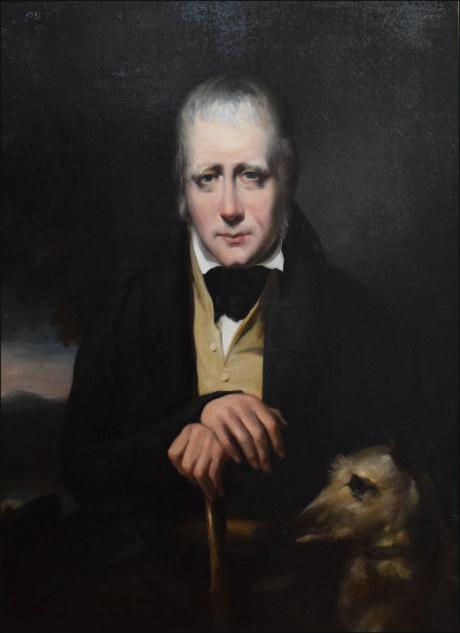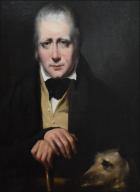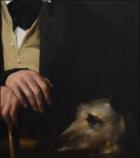Richard and Katrina Burnett, Finchcocks Musical Museum, Goudhurst, Kent
Francis Russell, Portraits of Sir Walter Scott, privately printed 1987, pp. 40-42 and plate 26.
The three-quarter length portrait painted by Sir John Watson Gordon in 1830 presents Scott in full face and seated with his hands resting on his walking stick. He is wearing a dark green coat and a yellowish waistcoat. His dog Bran sits to his right and a view of the Eildons may be seen to the left. 1830 is significant as by this time Scott had lost his wife, fortune and beloved grandson hence the rather melancholic and reflective demeanor in this portrait . Raeburn's iconic portrait was painted in 1822, at the peak of his powers.
This portrait was commissioned by Scott's publisher Robert Cadell specifically so that it might be engraved for the 'Magnum Opus' edition of the Waverley Novels (1829-33). Scott was loath to sit for a new painting and would have preferred Cadell to use the 1821 portrait by Sir Thomas Lawrence. The copyright to the Lawrence portrait had, however, been bought by another publisher, and Scott finally granted Watson Gordon a single sitting on 4 March 1830. Watson Gordon had, in fact, already commenced work on the portrait, basing his likeness on a bust prepared by the sculptor Lawrence Macdonald and on his own acquaintance with Scott. Bran, whom Scott received as a present at the end of March, was added at a later date.
Despite the sitter's reluctance, Watson Gordon's 1830 portrait is among the most acclaimed likenesses of Scott. Scott's son-in-law and biographer John Gibson Lockhart thought it 'masterly' and had 'only the disadvantage of having been done a little too late' (Memoirs of the Life of Sir Walter Scott, Bart., VII, 276). When John Horsburgh's engraving of the portrait appeared in 1832, the Edinburgh Advertiser declared: 'Here the desideratum of a really characteristic and expressive likeness of Sir Walter is at length gained. We cannot conceive, indeed, any portrait more exactly like, and at the same time so easy and graceful' (3 February 1832). The Edinburgh Weekly Journal found it 'deeply affecting', noting that 'the painter has been so happy as to catch a moment of fine poetical thought, which [Scott's] countenance sometimes but not often exhibited' but that 'his countenance tells the tale of much toil and labour encountered, as well as of his share of suffering and sorrow endured'. Scott appears 'older than he actually is, and those lineaments which formerly played responsive to the varying thought, are now fixed in the habitual contemplative character of his mind' (8 February 1832).
At least five engravings were made of the complete portrait: by John Horsburgh (1831), Blanchard (1833), Henry Robinson (1836), William Holl the Younger (1841), and 'C.R.' (1890). Signed derivations were engraved by Henry Bryan Hall (1837), T. Crawford (1838), W. C. Wrankmore (1845), and A. G. Campbell (1868). Five further unsigned derivations have been recorded. In addition, three signed replicas of the portrait were painted by Watson Gordon, including one for the Speculative Society (see below) where Bran sits to Scott's left. This portrait is one of the five version painted.
Scott was famous for his love of dogs, and they more often than not appeared in portraits with him. He cancelled a dinner engagement on the death of one, Camp, and buried him in sight of the window where he usually wrote. The friend who had expected Scott completely understood why he couldn’t face company that evening. Scott also gave his name to a breed of dogs. The Dandie Dinmont is named after a character based on James Davidson, who originally bred them in Guy Mannering.
Maida was a deerhound given to Scott by a friend and would become his dearest canine friend. Outside the door of Abbotsford, Scott’s Borders home, a statue of Maida lies with the words “Maidae marmorea dormis sub imagine Maida / Ante fores domini sit tibi terra levis” carved around it. “Beneath the sculptured form which late you wore sleep soundly, Maida, at your master’s door.”
Known for popular historical novels such as Ivanhoe and The Pirate, writer and poet Sir Walter Scott was born in Edinburgh, Scotland, in 1771. He is notable in that he was popular throughout his lifetime and earned an international reputation that was highly unusual for the time. Many of his works are still seen as classics today and they have been filmed and serialized on TV for audiences across the globe.
Apart from his literary genius, he was also a lawyer, an adept politician, and an influential member of the Highland Society which was founded 1784. After recovering from polio when he was a child, Scott was sent to his grandparents in the Scottish countryside to convalesce where he learned to read under the tutelage of his Aunt. He also became enraptured by the oral tradition of the Scottish Borders and learned many of the tales that would become part of his literary work.
By 1778, Scott was back in Edinburgh, going to school and reading widely but also learning about Scottish history from James Mitchell. From there he went on to read the classics at the University of Edinburgh where he met poet Thomas Blacklock. Scott began to study law to follow in his father’s footsteps as a solicitor and in 1792 he became a member of the Faculty of Advocates.
His writing career began with translating a number of works from German into English. In 1797 he married Charlotte Charpentier and they had five children together. He was enjoying success as a solicitor and in 1799 became Deputy Sheriff of Selkirk. In 1805 his poetry began to gain a public following after his friend, James Ballantyne, began to publish some of his work. The poem that pushed Scott into the limelight was The Lay of the Last Minstrel which told an old story of love and intrigue in the Scottish Borders.
The following ten years were a prolific period for Scott and he published many more poems with the help of Ballantyne, including The Lady of the Lake and Marmion. He became a partner in Ballantyne’s printing business and helped to create the Quarterly Review for the Tory party that was used as an expression of his political views.
Not satisfied with just writing poetry, Scott turned his hand to stories and novels, trying to bring to life the legends and tales that he had heard of the Scottish Borders in his youth. He published Waverly, a tale set in the Jacobite Rebellion, anonymously, and that was followed by various other novels such as Tales of My Landlord. Scott’s background as a lawyer served him well in his writing and he remained anonymous for a while, thinking that novels were a lesser form of writing than his popular poetry.
He moved away from Scotland for perhaps his most famous work, Ivanhoe, which was published in 1819. It was an immediate success and was translated into many languages, gaining Scott an international reputation. His reputation was further enhanced when he was asked by the Prince Regent to recover the Crown Jewels which had been lost after the coronation of Charles II. With a small band of officers, Scott discovered them buried in Edinburgh and was asked to create a pageant to celebrate the event.
But storm clouds were just around the corner. In 1825 there was a worldwide banking crisis and the printing business he had invested in heavily failed, leaving him owing £130,000. Scott was determined to write himself out of debt, but his health was beginning to fail and in 1832 he passed away still owing money.
His books continued to sell after his death, though, and shortly afterwards the debts were paid off.
Sir John Watson Gordon (1788–1864), painter of historical subjects and portraits, was born in Edinburgh. He was descended from the Watsons of Overmains, Berwickshire, and he was the son of Captain James Watson of the Royal Artillery. John Watson trained to follow his father into the army, but before receiving his commission took drawing lessons with John Graham at the Trustees' Academy in Edinburgh and studied with his uncle George Watson, who was the first president of the Scottish Academy, and also with Sir Henry Raeburn, who was a family friend, and decided instead to become a painter. In order to distinguish himself from his cousin and his uncle who were both artists, he later assumed the name Watson-Gordon and appears as such for the first time in the catalogue of the 1826 exhibition of the Royal Institution, Edinburgh, of which he was an associate.
Watson-Gordon is today best remembered—and is still highly regarded—as a portrait painter, but his earliest works were genre scenes. His diploma picture, A Grandfather's Lesson, depicted his father tutoring a fair-haired girl. Like many works of the time it suffered from bituminous cracking caused by the addition of tar into the blacks to enrich their lustrous effect. The stiff figures in another work, The Laird of Cockpen(McManus Galleries, Dundee), an interpretation of a well-known Scottish song, reveals the clumsy draughtsmanship of his earliest period. Another early work, however, a portrait of the songwriter Carolina Oliphant, Baroness Nairne and her Son William Murray Nairne (Scot. NPG) shows more skill. The lace edging to the sitter's cap and plum dress, her shining curls, and gentle expression are all expertly captured, although the physical grouping of mother and son is not entirely resolved. In 1808 Watson-Gordon exhibited a scene from Sir Walter Scott's Lay of the Last Minstrel at the first public exhibition held in Edinburgh; then, the following year, The Battle of Bannockburn and Queen Mary Forced to Abdicate the Crown. He continued to paint historical and religious subjects but after 1821 turned to portraiture and when Raeburn died in 1823, Gordon became the leading portraitist in Scotland. Like his uncle, in portraiture Watson-Gordon was greatly influenced by Raeburn's painting style. Thomas Clerk and his Wife (1820; Royal Company of Archers, Edinburgh), for example, shows clear similarities, in both composition and treatment, with Raeburn's Sir John and Lady Clerk of Penicuik (1792; NG Ire.), although this early work by Watson-Gordon lacks the atmosphere and bravura of Raeburn's double portrait. Watson-Gordon was a founding member of the Royal Scottish Academy in 1826, and was represented in the academy's annual exhibitions from 1830 until 1865. He also exhibited at the Royal Academy in London from 1827, becoming an associate member in 1841 and a full member ten years later. As a result his work became well known in England and many English people travelled to sit for him in his Edinburgh studio. Among them was the landscape artist David Cox, whose friends in Birmingham commissioned a three-quarter-length portrait of Cox from Watson-Gordon (Scot. NPG). Cox was reportedly delighted with the portrait and enjoyed the sittings in Edinburgh—he described Watson-Gordon as ‘affable and entertaining, with a grave and dignified carriage’ (Solly, 238). Watson-Gordon's portraits were both popular and critically acclaimed. With limited use of colour, dramatic lighting, and by focusing attention on the face, he managed to convey a heightened impression of the character of his sitters. He was especially successful when portraying the intellectuals of his day and painted most of the Scottish celebrities and writers of his time, including Lord Cockburn, James Hogg (in a rugged and romantic depiction The Ettrick Shepherd, swathed in plaid) (both Scot. NPG), and Sir Walter Scott (four portraits including an unfinished study of 1830, Scot. NPG), whom he painted many times. Scott was first portrayed by Watson-Gordon in 1820. He also commissioned from the artist a set of family miniatures for the travelling writing-case of his son Walter, who was in the army. Watson-Gordon was at his best when depicting older men. He managed to convey the shrewdness and wisdom of their years in apparently spontaneous, somewhat informal paintings, such as his portrait of Professor John Wilson of 1822; Raeburn had also painted Wilson, as a dashing young man wearing riding habit and standing next to a powerful horse (both paintings Scot. NPG). Watson-Gordon revealed the rugged features of his 68-year-old sitter in a less gallant but no less dramatic painting than that of Raeburn, painted several decades before. He was far more successful when doing this than when attempting to capture the essence of a youthful or female sitter, for example Mrs George Baird of Strichen (Tate collection).
Watson-Gordon's portraits of the earl of Dalhousie (1833; Archers' Hall, Edinburgh) and Lord President Hope (1832; Signet Library, Edinburgh) are important examples of the full lengths of his middle period, when his works were rich and varied in colour. In the latter the lord president is depicted in ermine robes standing before the colonnaded façade of Parliament House. His portraits Dr. Brunton and Principal Lee (Edinburgh University) indicate a change of style, which illustrates clearly the influence of photography on Watson-Gordon during the 1840s and 1850s.
In March 1850 Watson-Gordon was elected to succeed Sir William Allan as president of the Royal Scottish Academy. Shortly afterwards he was knighted and appointed royal limner for Scotland. In 1855 Watson-Gordon achieved international acclaim when he was awarded a gold medal at the Paris Universal Exhibition for his intimate and intense portrait of Roderick Gray, provost of Peterhead (1852; Merchants' Hall, Edinburgh). This painting, one of his finest, is characterized by its simplicity of composition and limited palette, the draperies and accessories being subordinated to the head, which is handled with great freedom, yet high finish, and on which is concentrated the main light and warmth of the picture. Many of his portraits were engraved, Edward Burton's mezzotint after the portrait of Roderick Gray being one of the most noteworthy.
In 1860 volunteer forces were springing up all over the country in reaction to increasing militarism throughout Europe. Watson-Gordon enrolled in no. 1 City artillery, which had sixty-four soldiers, many of whom were members of the Royal Scottish Academy. He donated £20 to the cause, in addition to the £5 subscription. Watson-Gordon died at Catherine Bank, Trinity, Edinburgh, on 1 June 1864. In his memory his brother and sister endowed the Watson-Gordon professorship of fine art, which was instituted at Edinburgh University in 1879 and was the first chair in art history in Britain.
Jennifer Melville DNB



